

Types of Cleats On A Sailboat
- July 18, 2023
Table of Contents
Cleats are essential fixtures on a sailboat used to secure lines (ropes) and control sail trim. They come in various designs and are strategically placed throughout the boat to provide convenient and secure attachment points. Here, I will describe the different types of cleats found on a sailboat in detail:
Sailboat Cleat Types
The horn cleat is the most common and recognizable type of cleat. It features one or more protruding horns or arms that provide multiple options for securing lines. The line is wrapped around the horns in a figure-eight pattern to create a secure hold. Horn cleats come in different sizes and are used for various applications throughout the boat, including halyards, sheets, and control lines.
Recommended Horn Cleats:

Ronstan Horn Cleat Nylon 76MM (3″)

Schaefer Mid-Rail Chock and Cleat Mounts on 1-1/4 x 3/16-Inch T-Track fits Up to 5/8-Inch/16mm Line
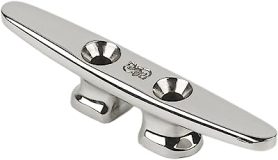
Cam cleats are designed with a spring-loaded cam mechanism that clamps down on the line when it is under tension. The cam grips the line securely and holds it in place until released. Cam cleats are popular for applications where quick and easy adjustment is required, such as controlling jib or spinnaker sheets. They are commonly found on sailboats with high-performance or racing-oriented setups.
Recommended Cam Cleats:

Jam cleats, also known as jamming cleats or rope clutches, are designed to hold a line firmly under load. They feature a set of ridges or teeth that grip the line when it is tensioned. Jam cleats provide a secure hold and are often used for halyards, control lines, and other high-load applications. To release the line, it needs to be pulled at a specific angle to disengage the teeth.
Recommended Jam Cleats:
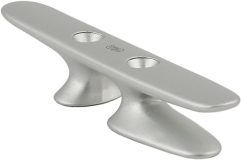
Clam cleats consist of two interlocking jaws that close around the line. As the line is pulled, the jaws grip it tightly, creating a secure hold. Clam cleats are often used for smaller lines, such as control lines on dinghies or small sailboats. They provide quick and easy adjustment and are commonly found on boats where weight and simplicity are crucial.
Recommended Clam Cleats:
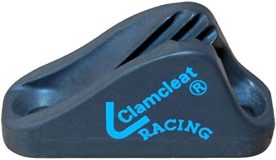
Osculati Clamcleat

V cleats, as the name suggests, have a V-shaped groove that runs along the top surface of the cleat. The line is inserted into the groove, and the V-shaped design holds it securely in place. V cleats are primarily used for smaller-diameter lines or control lines. They are commonly found on dinghies and small sailboats where space and weight are at a premium.
Recommended V Cleats:
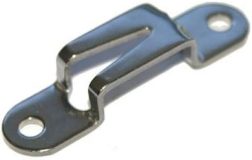
Nautos 91061 – V Jam Cleat – Sailboat Hardware
Jammers are similar to jam cleats but offer a more sophisticated and mechanical gripping mechanism. They consist of one or more jaws that grip the line under tension using a cam or lever system. Jammers provide a strong and secure hold and are commonly used for halyards, control lines, and sheets on larger sailboats or racing-oriented setups.
Recommended Jammers:
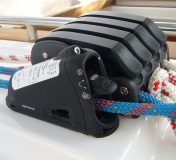
Spinlock Mobile Jammer for securing Loaded Lines 10-14mm

Rope Clutch
Rope clutches are heavy-duty cleats often used on larger sailboats. They consist of multiple jaws or disks that can be engaged or disengaged to secure or release a line. Rope clutches are designed to handle high loads and are commonly used for controlling halyards, sheets, and other lines that require precise adjustment and secure holding power.
Recommended Rope Clutches:
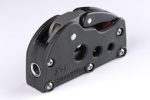
Deck cleats, also known as mooring cleats, are larger cleats that are permanently mounted to the deck or cockpit of a sailboat. They provide a secure attachment point for dock lines, fenders, and other lines used for docking or securing the boat. Deck cleats are usually made of durable materials such as stainless steel or aluminum and are designed to handle significant loads.
Recommended Deck Cleats:

Fairlead Cleat
Fairlead cleats combine the functionality of a cleat with that of a fairlead, which helps guide lines to the appropriate cleating position. They feature an integrated fairlead or a combination of a fairlead and a cleat. Fairlead cleats are commonly used for jib or genoa sheet control lines, where it is important to guide the line for optimal sail trim and secure it quickly.
Recommended Fairlead Cleats:
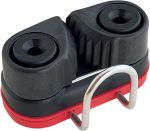
HARKEN Micro Carbo-Cam Cleat Kit w/Wire Fairlead
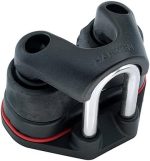
Jamming Block with Cleat
This type of cleat is a combination of a jammer or a cam cleat with a pulley or block. It allows the line to be redirected and creates a mechanical advantage when trimming sails. Jamming blocks with cleats are commonly used for applications that require increased purchase or control, such as mainsheet systems or complex control line setups.
Recommended Jamming Block Cleats:

It’s important to note that the specific cleat types and their placement on a sailboat can vary depending on the boat’s design, rigging setup, and intended use. Sailboat owners and manufacturers may also develop unique variations or combinations of cleats to suit their specific needs. Proper installation, sizing, and maintenance of cleats are essential for safe and efficient sail handling.
The Sailor’s Marketplace for Sailboats and Sails.
Sell Your Sailboat
Sailboats for sale.
- New Sailboats
- Used Sailboats
- Cruising Sailboats
- Racing Sailboats
Sell Your Sails
Sails for sail, sail manufacturers.
- North Sails
- Quantum Sails
- Doyle Sails
- UK Sailmakers
Sailing Reviews
- Sailing Line
- Safety Equipment
- Sailing Accesories
As an Amazon Associate SailTrader earns from qualifying purchases.
This website uses cookies to ensure you get the best experience possible.
JavaScript seems to be disabled in your browser. For the best experience on our site, be sure to turn on Javascript in your browser.
- My Wish List
- Compare Products
- Create an Account
- Dealer Locator
2022 SAILBOAT HARDWARE CATALOGUE
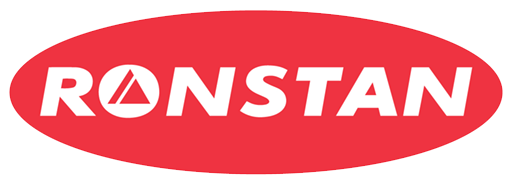
- You're currently reading page 1
- V-Cleats 6 items
- C-Cleats 19 items
- T-Cleats 2 items
- Swivel Cleat Bases 10 items
- Horn Cleats 5 items
- Rope Jammers 1 item
- Accessories 15 items
- Remove This Item
Need some advice?

Official Sponsors of the Australian Sailing Team

Shopping Cart
Your cart is currently empty..
FREE SHIPPING! for US Continental orders over $99 click for details
Sailboat Track Cleats & Accessories

T Track Adjustable Cleat 32 x 6

T Track Adjustable Cleat 40 x 8

Barton Marine
165mm (6.5") nylon sliding cleat fits 25mm (0.98") 't' track.

200mm Nylon Sliding Cleat - Fits 25mm T-Track

Stanchion Cleat

1 1/4 in SS Mid-Rail Chock Cleat

1 in SS Mid-Rail Chock Cleat
Track Cleats are a cost-effective solution to fitting a mid-ship spring cleat where access under the side deck is limited. It can easily replace a genoa track end stop.
MAURIPRO Sailing, your direct access to Sailboat Track Cleats & Accessories and all your other sailing and boating needs.
Copyright © 2024 MAURIPRO Sailing LLC.
- Deck Hardware
- Cleats, Chocks and Bollards
- Moveable Cleats
Toe Rail Folding Cleat

The toe rail folding cleat makes a perfect movable, mid-ship cleat for spring lines, etc.
| Item | Lead Time | Addl Image | Our SKU Mfg P/N | Specs | Status | Price | Quantity |
|---|---|---|---|---|---|---|---|
| SS Folding Toe Rail Cleat - 8 in. | 6 business days | | |
- Copyright 1998-2024 SB Owners, LLC. All rights reserved.

- Policies | Contact Us
- New Sailboats
- Sailboats 21-30ft
- Sailboats 31-35ft
- Sailboats 36-40ft
- Sailboats Over 40ft
- Sailboats Under 21feet
- used_sailboats
- Apps and Computer Programs
- Communications
- Fishfinders
- Handheld Electronics
- Plotters MFDS Rradar
- Wind, Speed & Depth Instruments
- Anchoring Mooring
- Running Rigging
- Sails Canvas
- Standing Rigging
- Diesel Engines
- Off Grid Energy
- Cleaning Waxing
- DIY Projects
- Repair, Tools & Materials
- Spare Parts
- Tools & Gadgets
- Cabin Comfort
- Ventilation
- Footwear Apparel
- Foul Weather Gear
- Mailport & PS Advisor
- Inside Practical Sailor Blog
- Activate My Web Access
- Reset Password
- Customer Service

- Free Newsletter

Blue Jacket 40 Used Boat Review

Catalina 270 vs. The Beneteau First 265 Used Boat Match-Up

Ericson 41 Used Boat Review

Mason 33 Used Boat Review

How to Create a Bullet-Proof VHF/SSB Backup

Tips From A First “Sail” on the ICW

Tillerpilot Tips and Safety Cautions

Best Crimpers and Strippers for Fixing Marine Electrical Connectors

Polyester vs. Nylon Rode

Getting the Most Out of Older Sails

How (Not) to Tie Your Boat to a Dock

Stopping Mainsheet Twist

Fuel Lift Pump: Easy DIY Diesel Fuel System Diagnostic and Repair

Ensuring Safe Shorepower

Sinking? Check Your Stuffing Box

What Do You Do With Old Fiberglass Boats?

Boat Repairs for the Technically Illiterate

Boat Maintenance for the Technically Illiterate

Whats the Best Way to Restore Clear Plastic Windows?

Stopping Holding-tank Odors

Giving Bugs the Big Goodbye

Galley Gadgets for the Cruising Sailor

The Rain Catcher’s Guide

Sailing Gear for Kids

What’s the Best Sunscreen?

UV Clothing: Is It Worth the Hype?

Preparing Yourself for Solo Sailing

R. Tucker Thompson Tall Ship Youth Voyage

On Watch: This 60-Year-Old Hinckley Pilot 35 is Also a Working…

On Watch: America’s Cup

On Watch: All Eyes on Europe Sail Racing

Dear Readers
- Sails, Rigging & Deck Gear
Practical Sailor Takes a Close Look at the State of Boat Cleats
Are boatbuilders taking cleats and other essential deck hardware for granted.
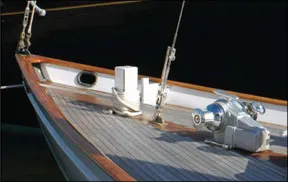
On average, a sailboat thats used 60 times a year actually spends only about 6 percent of its annual cycle underway. During the rest of the time, its either tied up, moored, anchored, or hauled out for maintenance, and when tallied up, this time can total as much as 94 percent of the year. That means that cleats (and docklines), rather than the person at the helm, will likely be in control of your sailboats destiny when the worst squall lines and cold fronts batter the fleet.
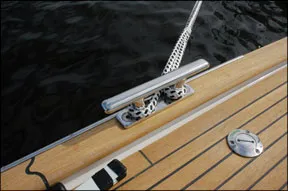
Photos by Ralph Naranjo
From this data, we can draw two important conclusions. The first is that we all need to spend more time underway, and the second underscores the importance of the cleat as an elegantly simple, yet most essential piece of hardware.
For centuries, timber-built craft relied upon one or two parallel vertical posts, often call “bitts,” that passed through the deck after being fastened to the keelson, floor frames, and deck beams. Lines were secured to these “Samson posts,” a nickname that alluded to pillars that only Samson was able to tear down. The trend to secure these line-handling bitts to major structural components of the vessel was based upon function rather than fashion, and it stemmed from the huge tension loads that could be imparted by docklines, tow warps, and anchor rodes. Bitts, along with the spoon-bow sloops and schooners that sported them, have all but disappeared from the waterfront, but the need for secure points to attach the cleats that usurped the role of the Samson post are as important as ever.
The concept of a cleat as a securing mechanism goes back to the 1400s, when antecedents to modern horn-type belaying cleats began to arrive on the scene. Eventually iron and bronze cast renditions were bolted to timber deck planking that incorporated additional under-deck reinforcement and load-spreading backing blocks. Today, in a era of stiff, light, foam-core decks, theres a need to carefully consider how energy is dissipated around cleat attachment points. For one thing, higher-density “infills” are necessary in regions where bolts secure a cleat to a cored deck. Some builders avoid this extra effort by placing cleats near the toerail, where the core is eliminated and the two fiber re-inforced plastic (FRP) skins of the deck have been brought together. This can be an adequate approach as long the laminate is thick enough or backed with a reinforcing (load-spreading) plate or extra units of FRP, and shoulder washers are used.
In addition to the structural issues involved, there are concerns over line leads and the need to make cleat use as safe and efficient as possible. Its easy to lose sight of how much energy a cleat must handle. In addition to steady-state line loads (normally in shear), there are a variety of angle and load oscillations associated with surging line loads. Fluctuations in the intensity can be linked to tidal rise and fall, along with force multipliers such as gusts and boat wakes.
Seiching, for example, is a low-frequency sloshing akin to what happens in a bowl of soup thats held in shaky hands. The net effect of such outside forces is to accelerate a tied-up vessel, adding a tension oscillation to the docklines or anchor rode. In many West Coast harbors, submarine canyons enhance this large-scale undulation, and seiching can greatly increase the wear and tear on both lines and cleats.

Cleats are the lynchpin in keeping a vessel where it belongs when conditions deteriorate. Recognizing their importance, we sent Practical Sailor Technical Editor Ralph Naranjo to the recent Annapolis and Miami boat shows on a mission to scrutinize the amount of attention designers, builders, and brokers have been placing on these crucial components. On his checklist were bullet points such as hardware positioning, fastening means, and most importantly, how the cleat handled the job at hand. He also looked to see whether the cleats (and chocks when used) were large enough to accommodate appropriate sized lines and anti-chafe gear. And finally, if a storm was in the forecast, how would the “doubling up” of docklines be handled?
These cleat-focused show visits revealed more than we initially anticipated: They highlighted that in many cases, a seafaring tradition lives on, and hardware and securing methodology were sound enough to do the job. In a few cases, such as with the “flip-up” horn cleats found of the luxury line of Oyster Yachts, there were true design innovations. But we also noted that some of the other hide-away cleat designs had to cope with water drainage and less-than-robust support structure, compromises that may not pay off in the long run. Even worse, some designers and builders seem to have dubbed cleats pass, substituting hard points such a rings and eyes as alternatives for line attachment. A few builders seemed to be placing cleats wherever they could find room to stick them. And in some cases, this meant on the transom rather than the deck itself. The result was a new set of point loads on the hull skin, plus a very awkward perch for line-handlers. This lackadaisical approach to cleat placement and the growing trend in the race-boat fraternity toward eliminating “cleat clutter” altogether, occasionally resulted in docklines being tied to pulpit stanchions, chainplates, and even stays and shrouds!
It seemed that less and less concern was given to the ergonomics of handling a line on a cleat. Its understandable that a foredeck crew in the midst of a spinnaker peel doesn’t want obstructions in the middle of their “court,” especially ones with lethal horns eager to snag a lazy guy or sheet. But from the opposite point of view, a crew adjusting docklines in a rough, gale-swept harbor needs easy access to securely mounted hardware.

A growing concern is that many manufacturers seem more concerned with how cleats and chocks look, rather than how they work. The most important consideration is whether or not a deck cleat carrying a full load can be handled without potentially sacrificing fingers.
Sheet-handling cleats in the cockpit belay lines that have been load dampened via turns around a winch drum. Just the opposite is true with a deck cleat. The energy contained in a stretching bow or spring line goes directly to a cleat. The load in the line is only slightly abated by a partial or full turn around the cleat, and when a crew member has a line in “hand,” good cleat placement allows a quick wrap to be taken without any appendages having to be placed in harms way.
Our boat-show foredeck roundup revealed a wide array of cleat/chock designs, and an even wider variation in how crews made up docklines and secured their prized possessions at center stage of these in-the-water events. Some boats, like the elegantly designed and artfully built mega-daysailer, the Friendship 53, featured cleats and chocks that kept with the theme of vessel-adding to the overall function and aesthetic appeal. The low-profile chocks and dropped-to-deck-level cleats handled braided docklines efficiently. The brokerage crew understood what they had in line-handling capability and displayed it well. With bow, stern, and double springs set, a crew could go home knowing that their sloop was securely tied to the dock. However, if storm warnings are posted, theres neither room for anti-chafe gear or room to double-up the lines.
Well over half of the boats tied up at the 2009 Annapolis and Miami boat shows displayed misled lines, foul leads, incomprehensible cleat hitches, and their brokers either ignored or were unaware of the glaring lapse in seamanship. One of the welcome exceptions to the rule belonged to Don Backe and members of Chesapeake Region Accessible Boating (CRAB), a sailing club for developmentally challenged individuals. The CRAB crew had several of their training boats on display (see photo on page 2), and despite the tight cramped confines, their lines ran fair, and anti-chafe gear had been used appropriately. Not one line was snaked back and forth like a cats cradle. Cleat hitches were properly made-in short, they displayed a fine example of good seamanship.
Line disarray was often more than just a hint about the priority given to cleats. In some cases, it was just the tip of a construction-shortfall iceberg. On several vessels festooned with floral arrangements, bowls of fruit, bottles of wine, and cute pillows, the cleats were jammed too close to the toerail, making line-handling difficult and fair leads all but impossible to attain. In the anchor lockers, we discovered little or no sign of extra reinforcement where the nuts and washers associated with cleat attachment came through the under deck. A few builders even preferred to bury aluminum plates in the laminate in order to provide reinforcement, a bad practice that, among other things, invites poultice corrosion.
- Race-Boat Alternatives
- Picks and Pans
- Design Details
- Cleat Refit Guidlines
- View PDF Format
RELATED ARTICLES MORE FROM AUTHOR
Leave a reply cancel reply.
Log in to leave a comment
Latest Videos
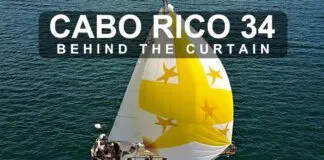
Cabo Rico 34 Boat Review

Super Shallow Draft Sailboat: The Leeboard Sharpie

Hans Christian 41T – Boat Review

Seven dead after superyacht sinks off Sicily. Was the crew at...
Latest sailboat review.
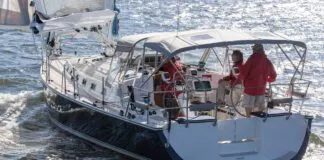
- Privacy Policy
- Do Not Sell My Personal Information
- Online Account Activation
- Privacy Manager
- Destination Information
- Sailing routes
- Boat owners
- Tips & Inspiration
- Sustainable Sailing

- Featured Posts: The Latest News
- Nautical Knowledge
The Sailboat Cleat: A guide to types and uses
- 24 March 2023
- 4 minute read
Alice Martin

Share the post "The Sailboat Cleat: A guide to types and uses"
If you’re a sailing enthusiast or just interested in learning more about sailboats, then Click&Boat has got your covered! Today, we’re going to explore the humble Sailboat Cleat – a small but mighty component that is essential for smooth sailing. So, batten down the hatches, and let’s set sail!
What is a Sailbo at Cleat?
It is a small metal or plastic fitting that is attached to the sailboat’s deck. This nifty device helps to secure ropes or lines that are attached to the sails or other parts of the boat. The Sailboat Cleat has two horns or arms, and ropes are wrapped around these arms to hold them in place.
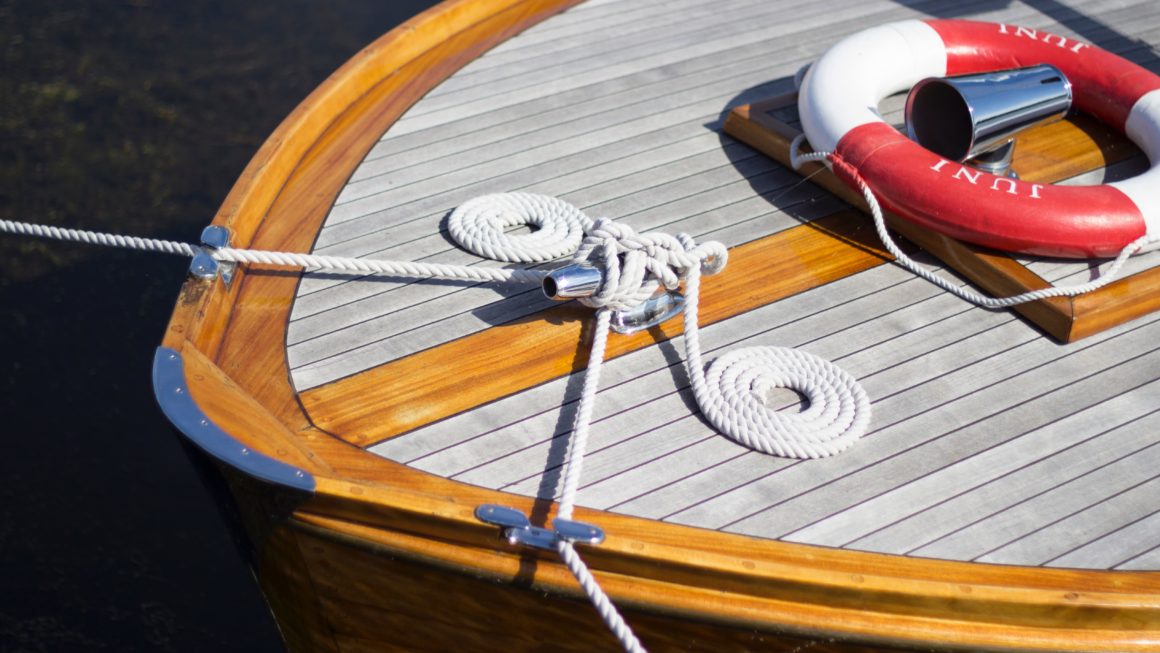
What is a Sailboat Cleat made of?
Manufacturers typically use a range of materials, such as metal, plastic, and wood, to make sailboat cleats. Metal cleats, made from stainless steel, brass or aluminium and sailors consider them more durable. Plastic cleats, often made from nylon or other synthetic materials, are lightweight and affordable, but might not withstand heavy loads as well as their metal counterparts. Wooden cleats, on the other hand, add a touch of traditional charm and can be found on classic or vintage boats. The choice of material depends on factors like cost, strength, and aesthetic preferences.
Why is a Sailboat Cleat So Important?
Sailboat Cleats are essential for sailing because they allow sailors to control the sails and other parts of the boat safely. By securing lines to these, sailors can adjust the sails’ angle and tension, which affects the boat’s speed and direction. Without them, sailors would have to hold onto the lines continuously, which would be tiring and inefficient.
They also play a crucial role in the boat’s safety. By securely holding the lines, they prevent the sails from accidentally unfurling or becoming tangled, which could cause the boat to capsize or become unmanageable.
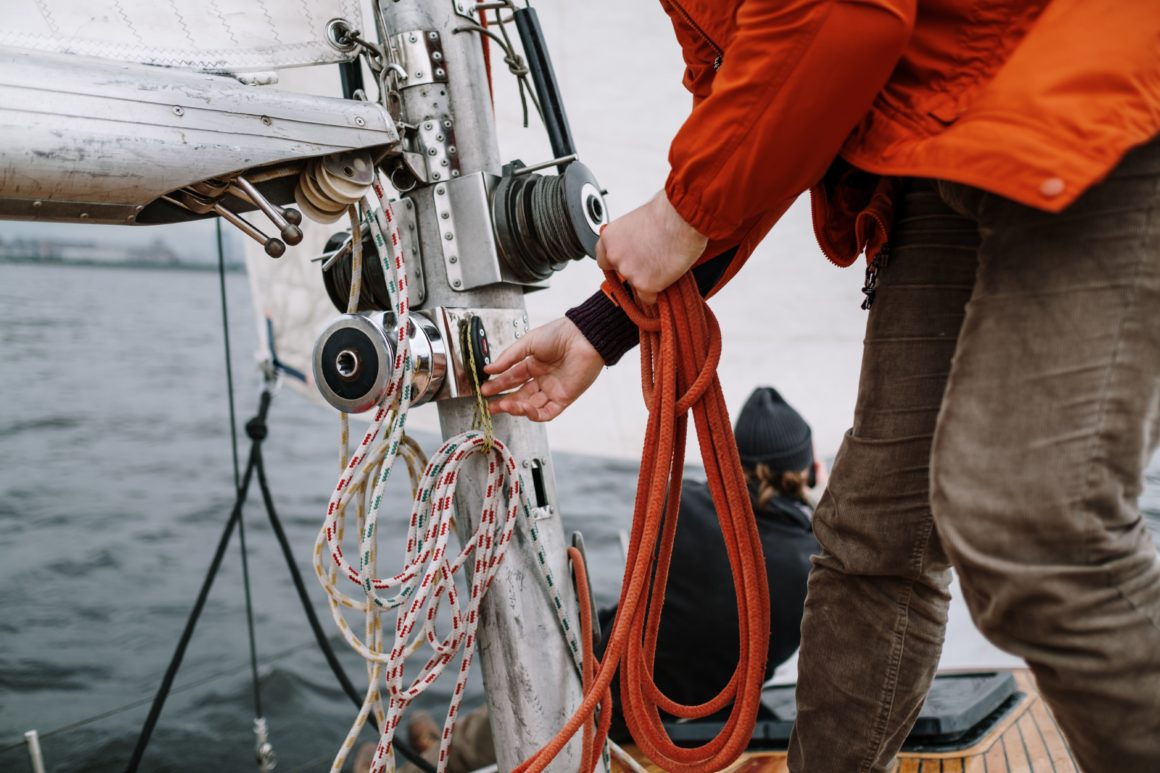

What are the different types of Sailboat Cleats?
Now lets explore some of the different types of cleats out there. There are different types of cleats, from traditional horn cleats to high-tech cam cleats that sailors can use depending on their sailing style. Lets take a look!
Horn Cleats
These are the most traditional type of Cleat and are still popular today. Horn Cleats have two upward curving arms that sailors use to hold the rope securely in place. In addition to traditional Horn Cleats, sailors can use rope clutches or shaped slots on larger boats to secure control lines.
Cam cleats use a spring-loaded cam mechanism to grip the rope tightly when sailors push it down. These are popular for racing sailboats, where quick and easy release is essential.
Clam Cleats
Similar to Cam Cleats, clam cleats use a spring-loaded mechanism to hold the rope in place. However, the rope is held between two jaws rather than a cam, which can provide a more secure grip.
These cleats are designed specifically for the jib sheets and are often found near the front of the boat. They are typically smaller than other cleats and can hold thinner ropes.
Deck Cleats
Deck cleats hold larger ropes and lines and can be made of metal, plastic or other materials, and sailors use them for docking and anchoring.
How Does a Sailboat Cleat Work?
Cleats hold ropes or lines securely in place while still allowing them to be released quickly and easily when necessary. They work by providing a secure anchor point for the rope, which can then be wrapped around the cleat’s arms multiple times to increase the holding power.
When the rope is wrapped around, it’s important to ensure that it’s done correctly that the line is held securely. The rope should be wrapped around the cleat at least three times, with each wrap crossing over the previous one. This ensures that the line is held securely, and the wraps don’t slip when the rope is under tension.
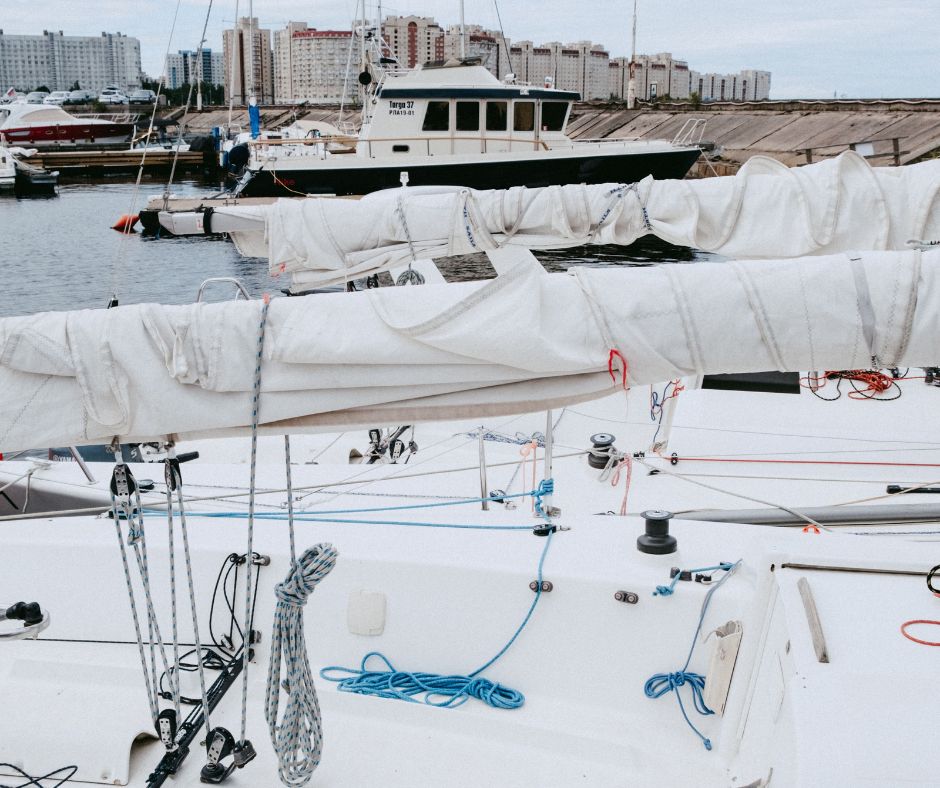
How to tie a Cleat knot
Tying a cleat knot is a useful skill to have for securing a boat or tying down a load. To tie a cleat knot, sailors start by wrapping the rope around the base of the cleat in a figure-eight pattern. Then, cross the rope over itself and loop it under the opposite horn of the cleat. Bring the rope back over the top of the cleat and create another figure-eight wrap around the opposite horn. Finally, cross the rope over itself once more and tuck the end under the last wrap. Pull the knot tight and it should be secure. With a little practice, tying a cleat knot can become a quick and easy task.
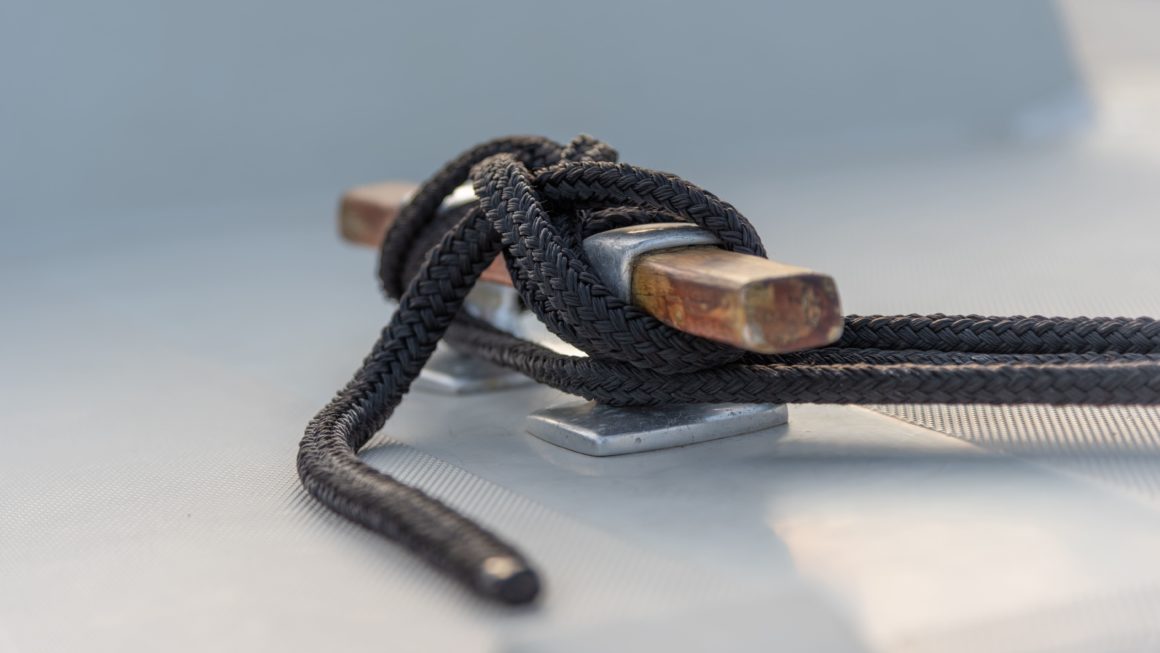
So, now that you are familiar with all the moving parts, you can appreciate just how important they are for a safe and enjoyable sailing experience. From small keel boats to larger vessels, these pieces of sailing hardware are important. So, next time you’re out on the water, give your cleats a little nod of appreciation. After all, they’re the unsung heroes of the sailing world!
50 Essential Sailing Terms For Every Sailor
- 20 March 2023
- Kate Fitzgerald

- Inspiration
Family Boating: The Ultimate Guide
- 31 March 2023
- Clara Chambers
You May Also Like
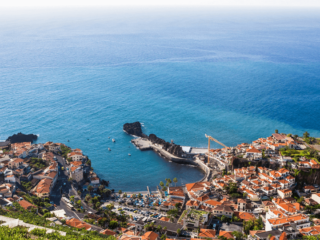
Discovering Madeira: boat trip ideas to explore the island
- 7 September 2024

Your City Break Holidays to Barcelona During the America’s Cup
- 21 August 2024
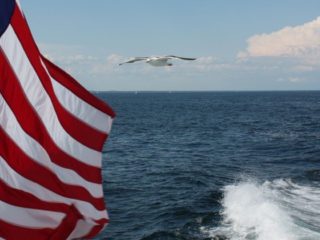
What you need to know for a boat safety certificate in the United States
- 7 July 2024
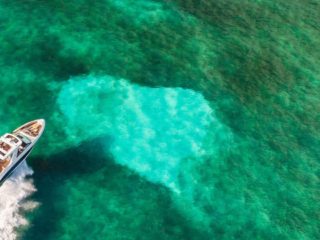
Budgeting for your daily boat hire
- 6 July 2024
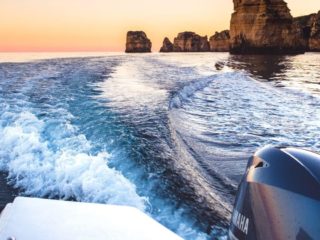
For your next motorboat trip: A skippered or a bareboat charter?
- 3 July 2024

What to bring aboard a motorboat: your boating checklist
- 1 July 2024

First time renting with Click&Boat? Here’s What You Need to Know!
- 30 June 2024

- About Click&Boat
Click&Boat’s guide to using a boat licence abroad
- 29 June 2024
Leave a Reply Cancel reply
Your email address will not be published. Required fields are marked *
Save my name, email, and website in this browser for the next time I comment.
This site uses Akismet to reduce spam. Learn how your comment data is processed .
Input your search keywords and press Enter.

Your cart is empty
Use this bar to show information about your cookie policy.
The Ultimate Guide to Boat Cleats: Choosing, Installing, and Using Them Effectively
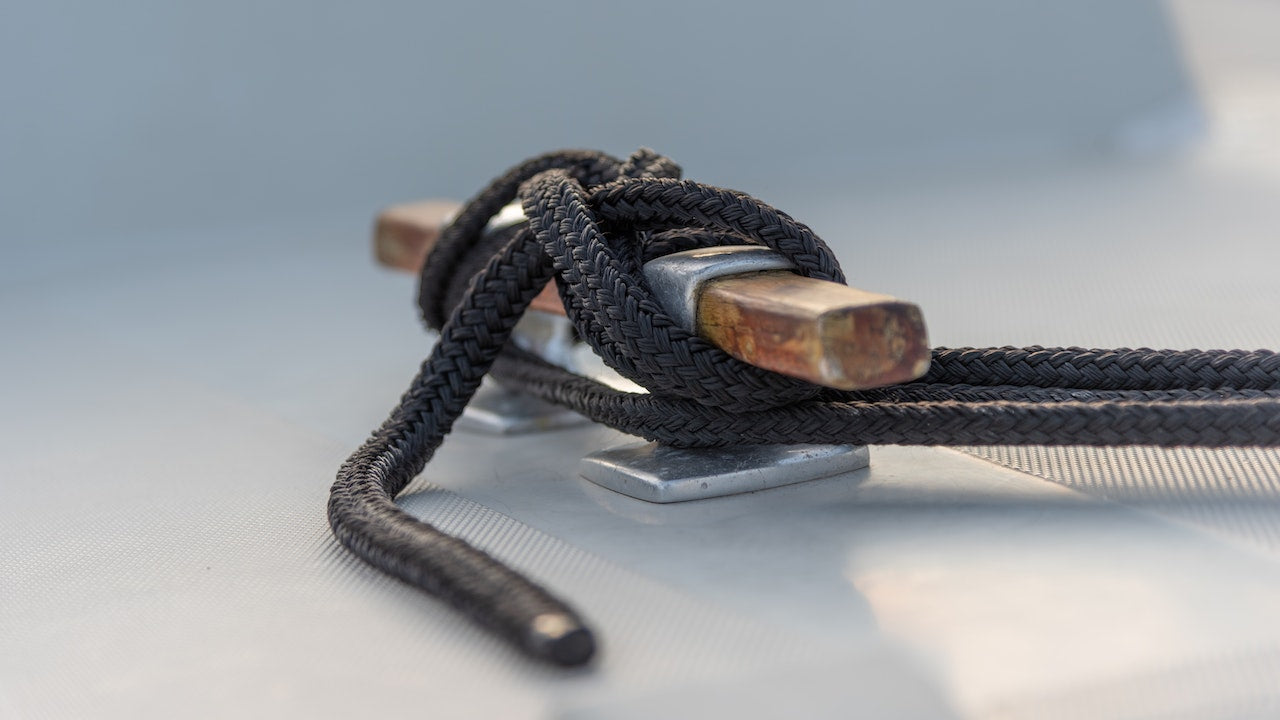
Whether you are just starting your nautical journey or are a seasoned sailor, we believe it is always beneficial to brush up on essential boating knowledge.
Today, we steer the conversation to an often overlooked, but vital component of boating safety and functionality - boat cleats. In this guide, we'll take a deep dive into the world of boat cleats, providing you with everything you need to know to make informed decisions when choosing, installing, and using them effectively.
A Cleat Introduction: Why Are Boat Cleats Necessary?
Boat cleats serve as the anchoring point on your boat or dock, allowing you to secure lines for a variety of purposes including mooring, anchoring, or towing. Having the right cleat installed not only ensures the safety of your vessel but also prolongs the lifespan of your marine equipment. Understanding the intrinsic role of cleats can pave the way for a seamless and enjoyable boating experience. As a side note: make sure you never leave your boat unattended for long periods of time without being properly secured .
Choose Wisely: Picking the Right Cleat for Your Needs
Material matters.
When it comes to selecting the right cleat, material should be your first consideration. The common materials are:
- Galvanized Steel Cleats: Galvanized steel cleats are cost-effective options that offer resistance against corrosion, suitable for both fresh and saltwater setups.
- Nylon Cleats: Ideal for small and medium-sized boats; they are lightweight, durable, and resist corrosion extremely well. Tommy Docks offers a variety of nylon cleats from traditional horn cleats to foldable cleats.
- Aluminum Cleats: Light yet durable, offering resistance to corrosion, making them a top choice for freshwater environments.
Shape and Style
Next, consider the shape and style of the cleat which determines its functionality. The popular types are:
- Horn Cleats: Traditional and versatile, boat horn cleats are commonly found on most boats and docks.
- Foldable Dock Cleats: Foldable dock cleats are best for smaller boats, they can be quickly and easily folded away so as to give more walkable space on your dock without the worry of stubbing a toe!
- S-Shape Cleats: With a unique design, they prevent lines from slipping off, providing an additional layer of safety.
Size Considerations
Choosing the right size is crucial to ensure proper functionality. A general rule of thumb is to opt for a cleat that is approximately one inch in length for every 1/16 inch diameter of the rope used.
Installing Cleats: Securing Your Peace of Mind
A well-installed cleat can be the difference between a secured boat and a drifting vessel. Here are some steps to install cleats like a pro:
- Select an Appropriate Location: Choose a spot that allows easy access while avoiding potential tripping hazards.
- Mark the Holes : Once you have identified the right spot, mark the holes using a marker.
- Drilling the Hol es: Use a drill to make holes at the marked points, ensuring they are slightly larger than the bolts to be used.
- Fixing the Cleat: Position the cleat over the holes and secure it using appropriate bolts, adding a washer and nut underneath.
- Sealing the Deal: Apply a marine sealant around the bolts to prevent water from seeping in, thereby avoiding potential corrosion.
Using Cleats Effectively: Mastering the Art
Using a cleat effectively is an art that mariners should master to ensure safety and efficiency. Here’s how you can do it:
- Making a Cleat Hitch: Learn to tie a cleat hitch correctly. Start by making a loop around the base, followed by a figure-eight pattern around the horns, securing it with a hitch on the final turn.
- Proper Line Handling: Ensure that the lines are not frayed or damaged, as this could compromise the safety of your boat.
- Regular Inspection: Periodically inspect the cleats for signs of wear and tear, and replace them as necessary to maintain optimal functionality.
If you want a more in-depth guide on how to tie your boat to a dock, check out this guide by Tommy Docks .
Sailing Ahead: Final Thoughts and Recommendations
Remember, the heart of a secure and functional docking system lies in its smallest details. By investing in quality boat cleats and using them correctly, you not only safeguard your vessel but also ensure a delightful and worry-free boating experience.
At Tommy Docks, we are committed to providing you with top-notch prefab dock kits and equipment (including boat cleats!) that stand the test of time. For more guidance and expert advice, feel free to sail into our world, where quality meets innovation.
Get the latest news, updates and exclusive offers.
Tommy Docks Podcast
Listen along as Tommy Dock's Owner Owen Jones explores the meaning of living on the water. Dive deeper into conversation with industry experts on everything outdoors. Don't be a stranger, grab a beer and join us on the dock.
Listen Here
Featured products
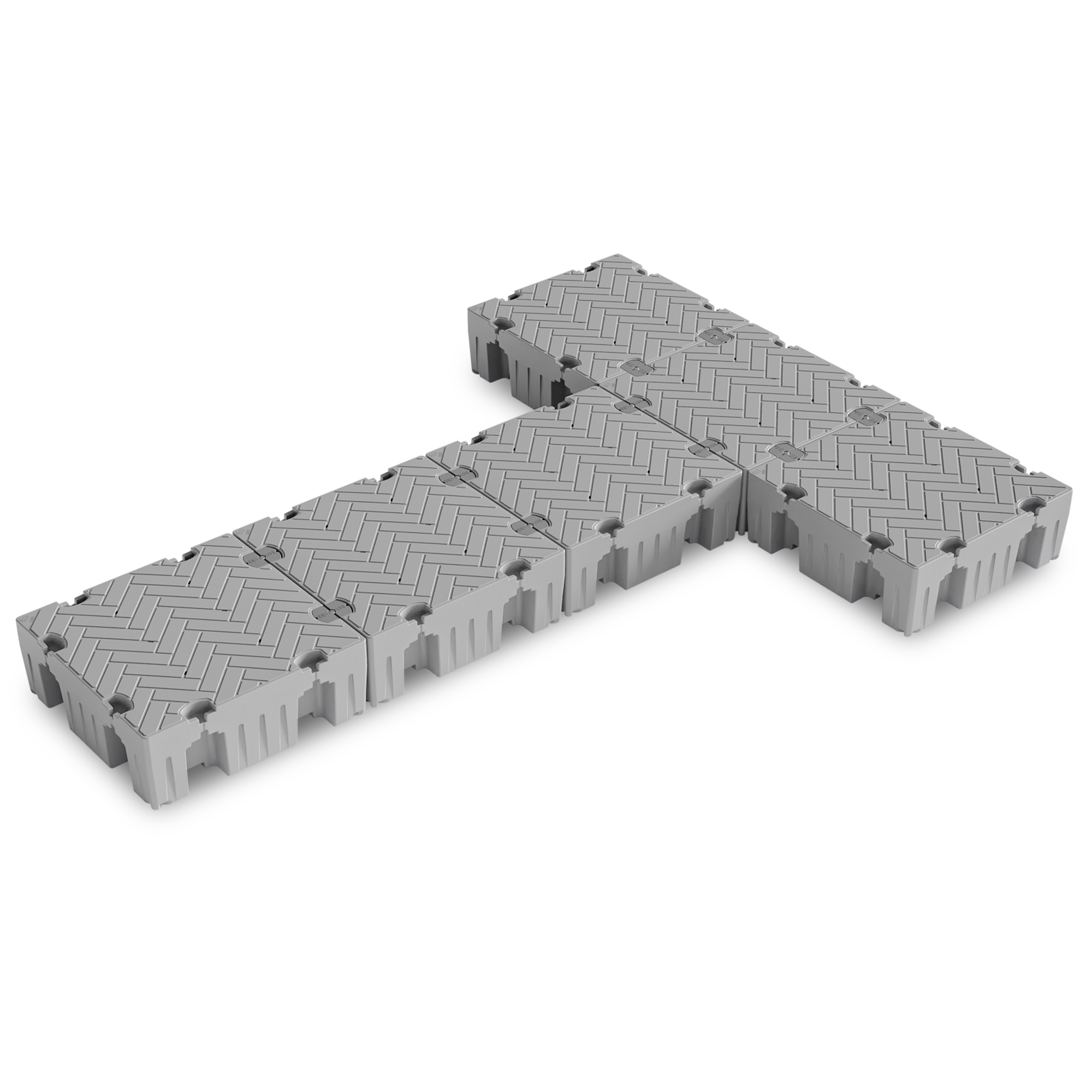
Happy Customers
Over 750+ 5-Star Reviews and counting.
Customer Service
Have questions? Contact us by chat, email, phone.
Warranty Support
Sometimes the unexpected happens. View Policy
- Opens in a new window.
You are using an outdated browser. Please upgrade your browser or activate Google Chrome Frame to improve your experience.
War Eagle Boats
- Accessories, Paint & Vinyl
- Request Literature
- Dealer Locator
- Download Catalog
- Owner Benefits
(870) 367-1554
Enter your zip code and we’ll locate the dealer nearest you.
Read More About Us
Locate a war eagle dealer, browse our products, sportsman models, blackhawk series, crappie models, predator series, vs stick steering models, bass models, tomahawk series, renegade models, t-lock/cap rail products.
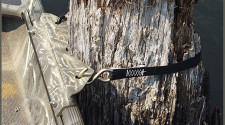
Lock Jaw Bracket
Lock Jaws are available to make your boat a solid hunting platform. This devise secures your boat to a tree for greater stability in timber hunting conditions. Learn More
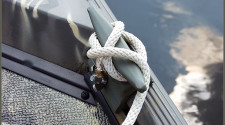
Cleat Bracket
Attaches anywhere along our T-Lock Cap Rail system. Great for tying off or anchoring your boat. Learn More
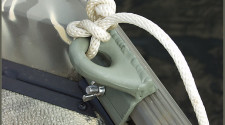
Cap Tie Bracket
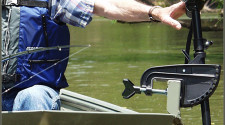
Hand Trolling Motor Bracket
A mounting plate that extends above the cap rail, which a hand operated trolling motor attaches to. The hand trolling motor bracket can be attached anywhere along our cap rail with War Eagle's stainless steel T-Lock system. Learn More
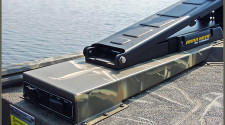
Foot Trolling Motor Bracket
The foot trolling motor bracket is mounted on the bow seat. May be mounted on either left or right side. Optional 12 volt or 12/24 volt wiring systems are available. Learn More
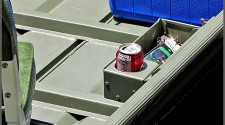
Drink and Shell Tray
Attachment that holds your drink while providing a tray for shells or other small items such as your cell phone and keys. This tray can be attached anywhere along our T-Lock Cap Rail system. Learn More
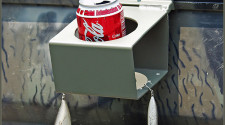
Drink Holder
Simple attachment that holds your drink. Constructed from aluminum, this accessory easily attaches anywhere on our cap rail system. Includes holes in the bottom suitable for hanging spinner baits. Learn More
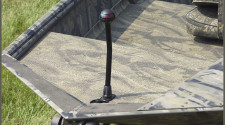
Navigation Lights
War Eagle’s navigation light system complies with all United States Coast Guard regulations. This bow and stern light combination is wired to an on/off switch for standard use. Learn More
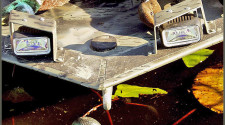
Rainbow Lights or Docking Lights
These lights are commonly used to unloading or loading your boat on the trailer. They work great when running in flooded timber or docking your boat in low light situations. Learn More
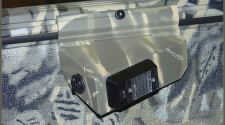
Q-Beam and Courtesy Light Combination
Q-Beam is a 12v outlet for a hand-held spotlight. You can use it to charge cell phones or any other 12v accessory. Courtesy light has a separate switch on the light for use only when you need it. It provides ample lighting for tying on a lure or separating decoys. The Q&C Combo can be mounted to the cap rail in the boat for your convenience. Learn More
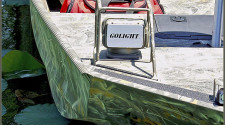
Remote Spotlight
The remote control spotlight is mounted on the bow and Includes a bracket with a brush guard for protection. It is operated by a toggle switch that is located on the console, on the grab rail, or on a bracket mounted in our cap rail. Learn More
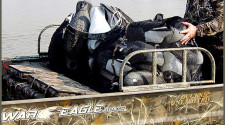
Cargo Rails
Rails attach to the cap rail and hold decoys or other equipment in place. Cargo Rails allow you to stack equipment on the rear deck without worrying about it falling out or shifting. Learn More
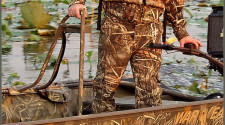
Mud Motor Hand Rail
Rail provides stability for drivers who stand to operate shallow running mud motors. Gives the driver better control without taking up much space in the boat. Learn More
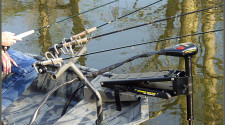
Spider Rig Rod Holder
Rod holder fits easily into base plate and accommodates up to 4 rods. Great for crappie or bream fishing! Rods are held securely in place, but easy to remove when your cork goes under! Learn More
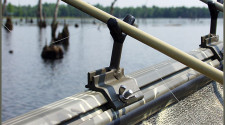
RGT Rod Support
Inspired by renowned crappie guide Roger Gant, this Y shaped support attaches to the T-lock Cap Rail system. The RGT supports your rod while making it easy to lift up and adjust your position. Learn More
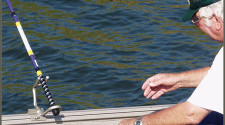
War Eagle’s basic rod holder attaches to the T-Lock Cap Rail system. It holds rods securely in place and fits all rod sizes. Rod Holders are made from heavier bar stock aluminum and our suitable for trolling big fish. Learn More
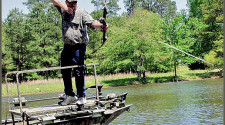
Bow Fishing Deck
Stable platform attaches to front deck and provides bow-fishing area for two. Four lights are attached around the bottom of the platform to illuminate murky waters. Constructed from aluminum to resist corrosion and painted to match your boat. Learn More

War Eagle’s Lab Step provides your retriever with a sturdy and dry platform while he stands at ready. After retrieving your ducks, the Lab Step helps the hunter’s best friend reenter the boat from the water. This fold out platform gives your retriever a foot up to get back into the boat. Learn More
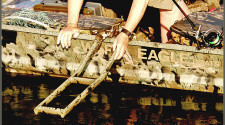
Step that easily folds in and out of the boat. Provides a step for hunters wearing waders helping them to get in and out of the boat. On larger models, the bubba step is useful for water skiers. Learn More

Please verify you are a human
Access to this page has been denied because we believe you are using automation tools to browse the website.
This may happen as a result of the following:
- Javascript is disabled or blocked by an extension (ad blockers for example)
- Your browser does not support cookies
Please make sure that Javascript and cookies are enabled on your browser and that you are not blocking them from loading.
Reference ID: d7151b82-755c-11ef-b3b8-5f3576c61dd9
Powered by PerimeterX , Inc.

- Sports & Outdoors
- Boating & Sailing
- Docking & Anchoring Equipment
- Boat Fenders

Image Unavailable

- To view this video download Flash Player
New 2X Boat Fender Hanger, Boat Rail and Cleat Fender Clips, Quick Connect and Release Fender Lines, Boat Bumper Adjuster
Purchase options and add-ons
- Multi-Point Mounting: Our bumper adjusters are designed for more than just railings or cleats. You can easily mount them on various parts of your boat, ensuring versatility and convenience for all users
- Material: Crafted from high quality materials, our bumper adjusters stand up to the elements. Even in the harshest sun and saltwater conditions, they maintain their integrity and functionality
- Easily Use: No more struggling with knots or tangled ropes, simply press a button to release and lock the fender lines
- User-Friendly: Whether you're a seasoned sailor or just starting out, our bumper adjusters offer an intuitive and hassle-free docking experience, letting you say goodbye to complicated knots
- Package Includes: 2x Boat Bumper Adjusters
Product Description
Features: -- Fit for boat rail, grabs rail, cleats, latch and so on. -- You can easily hang the bumper horizontally without tying complex knots. -- Simply press the button and push the rope to adjust the height of the bumper. -- You can easily mount them on various parts of your boat, ensuring versatility and convenience for all users. -- Make quick and precise adjustments as you approach different dock heights. Save time and reduce the stress of docking.
Product information
Technical details.
| Brand Name | Amour preserveyy |
|---|---|
| Manufacturer | Amour preserveyy |
| Part Number | Boat Bumper Adjuster |
Additional Information
| ASIN | B0DH1SPWCY |
|---|---|
| Date First Available | September 14, 2024 |
Looking for specific info?
Customer reviews.
- 5 star 4 star 3 star 2 star 1 star 5 star 0% 0% 0% 0% 0% 0%
- 5 star 4 star 3 star 2 star 1 star 4 star 0% 0% 0% 0% 0% 0%
- 5 star 4 star 3 star 2 star 1 star 3 star 0% 0% 0% 0% 0% 0%
- 5 star 4 star 3 star 2 star 1 star 2 star 0% 0% 0% 0% 0% 0%
- 5 star 4 star 3 star 2 star 1 star 1 star 0% 0% 0% 0% 0% 0%
Customer Reviews, including Product Star Ratings help customers to learn more about the product and decide whether it is the right product for them.
To calculate the overall star rating and percentage breakdown by star, we don’t use a simple average. Instead, our system considers things like how recent a review is and if the reviewer bought the item on Amazon. It also analyzed reviews to verify trustworthiness.
No customer reviews
- Amazon Newsletter
- About Amazon
- Accessibility
- Sustainability
- Press Center
- Investor Relations
- Amazon Devices
- Amazon Science
- Sell on Amazon
- Sell apps on Amazon
- Supply to Amazon
- Protect & Build Your Brand
- Become an Affiliate
- Become a Delivery Driver
- Start a Package Delivery Business
- Advertise Your Products
- Self-Publish with Us
- Become an Amazon Hub Partner
- › See More Ways to Make Money
- Amazon Visa
- Amazon Store Card
- Amazon Secured Card
- Amazon Business Card
- Shop with Points
- Credit Card Marketplace
- Reload Your Balance
- Amazon Currency Converter
- Your Account
- Your Orders
- Shipping Rates & Policies
- Amazon Prime
- Returns & Replacements
- Manage Your Content and Devices
- Recalls and Product Safety Alerts
- Registry & Gift List
- Conditions of Use
- Privacy Notice
- Consumer Health Data Privacy Disclosure
- Your Ads Privacy Choices
- Bahasa Indonesia
- Slovenščina
- Science & Tech
- Russian Kitchen
10 most interesting places in Tver Region (PHOTOS)

1. Catherine the Great's ‘Travel Palace’ in Tver

The city was founded on the Volga River in 1135. It’s 12 years older than Moscow and even competed to become the capital of Ancient Russia. Today, it is a major regional center with a population of around 414,000 people.
Travelers from one capital to the other would often stop in Tver. Empress Catherine II even had a travel palace built in Tver so as to have somewhere to rest along the way. Now, it houses the Tver Regional Art Gallery. It includes artwork collections owned by Tver governors from country estates in the Tver Governorate that were nationalized after the Bolshevik Revolution. They contain works by Alexey Venetsianov, Konstantin Korovin, Arkady Plastov, Valentin Serov, Mikhail Vrubel and other famous artists.
2. Rzhev Memorial

The town of Rzhev is located 120 km from Tver. From October 1941 to March 1943, some of the bloodiest battles of World War II, including the ‘Battle of Rzhev’, took place there (you can read more about the battle here ). Soviet troops lost more than 1.3 million men, including wounded, missing in action and taken prisoner.
A memorial to the soldiers who fell in the battle was inaugurated in Rzhev in June 2020. At the center of the composition is a 25-meter bronze statue of a Soviet soldier whose trench coat "morphs" into a flock of cranes. The reference is to one of the most popular and poignant songs about the war titled: 'Zhuravli' ('Cranes'). It was composed by Yan Frenkel to lyrics by Rasul Gamzatov.
3. Lake Seliger

Lovers of outdoor recreational activities should visit the shores of Seliger at least once in their life! This huge (260 sq. km) lake of glacial origin is home to about 30 species of fish. Hence, fishermen go there at all times of year and fish from boats, from the shore and, in winter, through ice-holes.
The winding shoreline of the lake has a multitude of different hotels and campsites (as well as glamping sites), so anyone can stay there according to their preferences. And you can jump straight into the lake from the banya (bathhouse)!
One of Seliger's landmarks is the charming town of Ostashkov, the largest on its shores.. Its key attractions include a Soviet local history museum, which is housed in a former church.
You can also take a ride on a retro train along the Seliger - Ostashkov - Bologoye route.
Seliger train
4. Nilov Monastery (St. Nilus Stolobensky Monastery)

One of the main attractions in Tver Region is the Nilov Monastery, founded in the 16th century. This functioning monastery is also situated on the picturesque shores of Lake Seliger. In Soviet times, it housed a colony for young offenders, a prisoner-of-war camp, a hospital and a tourist hostel…
According to legend, a hermit monk named Nil, famous for his diligent prayer, settled on the island of Stolobny on the lake. It was said that no calamities or robbers could force him off the island. After he died, other monks began to go to where his cell had stood and, eventually, they founded a monastery there. Before the Bolshevik Revolution, it was one of the most revered monasteries: Thousands of pilgrims used to visit it to worship the relics of the Venerable Nil. As part of the project ‘Russia: 85 Adventures’, we filmed a video at the monastery – you can watch it here .

If, in Torzhok, you've time to eat, Pozharsky's is the place to know. Their cutlets, fried, are such a treat, Then after lunch you'll lightly go!
So wrote Alexander Pushkin, who frequently traveled from St. Petersburg to Moscow to see his friend Sergei Sobolevsky. Thanks to Russia's most outstanding poet, ‘Pozharsky cutlets’ – patties of ground chicken coated in white bread croutons – became the town's most famous speciality. And they remain its calling card to this day.

But, the town is famous for more than just gastronomy. The once major trading center has, today, evolved into a charming provincial town. Things to see include the picturesque scenery along the banks of the River Tvertsa, the Saints Boris and Gleb Monastery, which is virtually the oldest monastery of Ancient Russia (believed to have been founded in 1038), and the unique, wooden 17th-century Old Church of the Ascension.
6. The flooded bell tower of Kalyazin

One of the region's most famous sights is the flooded bell tower of Kalyazin. The 74-meter tower protrudes out of the water not far from the shores of a reservoir. Tourists who take pictures of it are sometimes oblivious of the fact that the ruins of a once-flourishing monastery lie hidden under the water.
Most of the Makaryev Monastery of the Holy Trinity was demolished in 1940, ending up in the flood zone of the Uglich hydroelectric power station on the Volga River and the Uglich Reservoir. What remains now as a reminder of the monastery are the bell tower, which was recently restored and re-whitewashed and also a set of frescoes miraculously rescued from the monastery. You can read more about them here .
7. The source of the Volga

It's hard to believe that this spring and stream in the Valdai Heights are the place where one of the world's biggest rivers (and the biggest in Europe) rises. Next to the spring stand a chapel and a footbridge with a plaque – an ideal spot for a souvenir selfie!
In Ancient Rus’, the River Volga was always held in special esteem – it was described as “Mother Volga”, a multitude of towns were built along it and it provided food for a large number of Russian regions and continues to do so to this day. This is why pilgrimages have been made to its source for several centuries now. Back in the 17th century, a monastery stood there, but it burnt down and was never restored. A new one was, however, built in 1912 – the Olginsky Convent.
8. Shirkov Pogost

This spot on the shores of Lake Vselug (today part of the Volga River) is dubbed the "Kizhi of the Tver Region". Like the famous Kizhi on Lake Onega , Shirkov Pogost is of interest because of its multi-tiered wooden church – in this case, the church of John the Baptist, a masterpiece of Russian wooden architecture, which was built in 1697.
According to one legend, the Pogost was named in honor of the Shirkov brothers, merchants who had the church built. They were taking two icons of John the Baptist from Novgorod to Moscow. On this spot, they laid down the sacred images and decided to rest, but they could not pick them up again – and, so, decided to build a church there without using a single nail!
9. Vyshny Volochyok
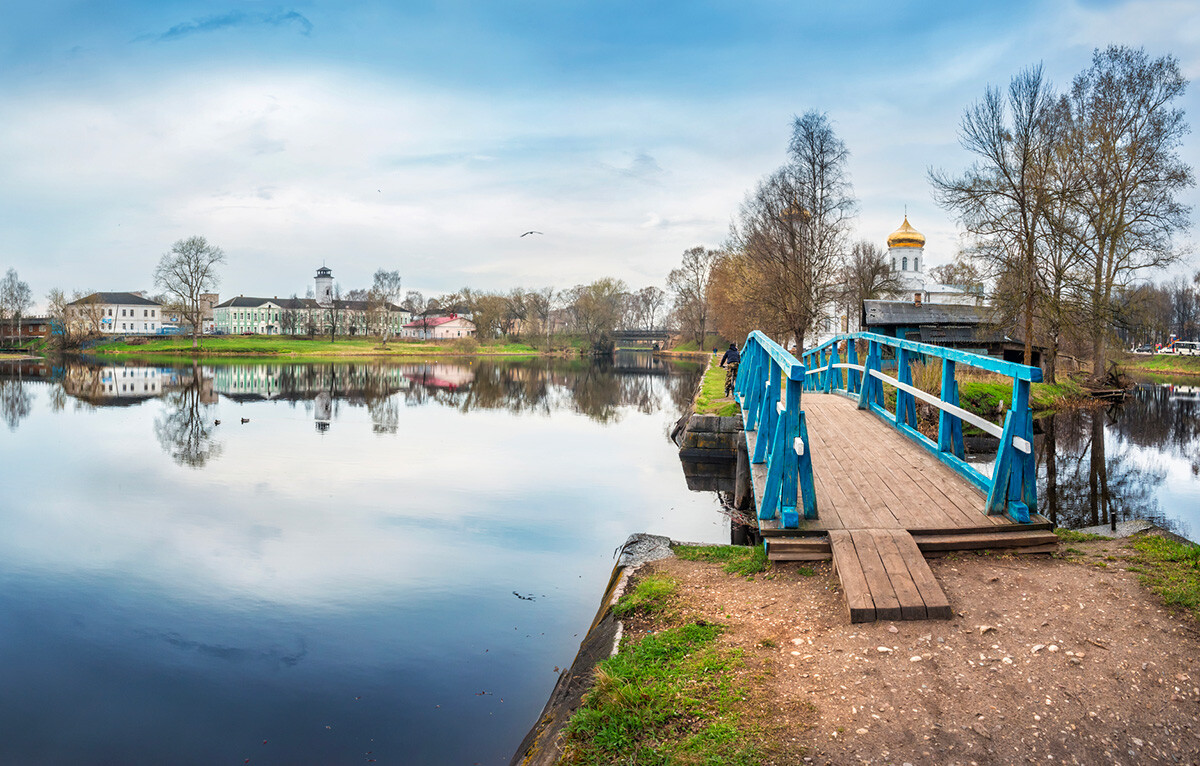
The town got its name from the word ‘volok’ (‘portage’) – in other words, various watercraft were carried across a section of dry land between two bodies of water there. True enough, Vyshny Volochyok was on the watershed of the basins of the Baltic (Tsna River) and the Caspian (Tvertsa River, a tributary of the Volga). Under Peter I, the first artificial canal in Russia was built between the two rivers.
Vyshny Volochyok was always an important staging post on the route from Moscow (and Central Russia) to St. Petersburg. Because of its convenient location, there were many factories and production plants there, from garment factories to glass and woodwork facilities. Volochyok is also famous for the manufacture of ‘valenki’ (‘felt boots’) and it even has a museum devoted to this footwear and to the art of wool hand felting.
A host of old factory buildings, as well as houses that once belonged to affluent merchants in a great variety of styles, have survived in the town. A roadside imperial palace was also built there, which, today, houses a school.
10. Konakovo

Until 1929, the village was called Kuznetsovo, after which it was renamed in honor of Porfiry Konakov, a participant in the 1905 Russian Revolution. The area is famous for its china. The Konakovo Pottery Factory was founded as early as 1809 and is one of the oldest in Russia. It is no longer in operation, but local craftspeople are using the legacy of its artistic workshop to revive production today. Items can be bought as a souvenir in Tver Region.
But, today's tourists know the location more as a fashionable riviera. Konakovo and nearby Zavidovo are popular places for recreational activities and water sports. People go sailing, wakesurfing and wakeboarding and there are a multitude of hotels and glamping sites for holiday stays. And the close proximity to the M11 motorway makes the location even more attractive (particularly to Muscovites, who can get there in just over an hour!).
Dear readers,
Our website and social media accounts are under threat of being restricted or banned, due to the current circumstances. So, to keep up with our latest content, simply do the following:
- Subscribe to our Telegram channel
- Subscribe to our weekly email newsletter
- Enable push notifications on our website
- Install a VPN service on your computer and/or phone to have access to our website, even if it is blocked in your country
If using any of Russia Beyond's content, partly or in full, always provide an active hyperlink to the original material.
to our newsletter!
Get the week's best stories straight to your inbox
- Pozharsky cutlets: Cooking the most tender and juicy croquettes EVER! (RECIPE)
- Toll roads in Russia: How they work and how to use them
- How to travel to Russia with a camper: Tips for novices
This website uses cookies. Click here to find out more.
Tver Oblast

- 2 Other destinations
- 3 Understand
- 6 Get around
- 11 Stay safe
<a href=\"https://tools.wmflabs.org/wikivoyage/w/poi2gpx.php?print=gpx&lang=en&name=Tver_Oblast\" title=\"Download GPX file for this article\" data-parsoid=\"{}\"><img alt=\"Download GPX file for this article\" resource=\"./File:GPX_Document_rev3-20x20.png\" src=\"//upload.wikimedia.org/wikipedia/commons/f/f7/GPX_Document_rev3-20x20.png\" decoding=\"async\" data-file-width=\"20\" data-file-height=\"20\" data-file-type=\"bitmap\" height=\"20\" width=\"20\" class=\"mw-file-element\" data-parsoid='{\"a\":{\"resource\":\"./File:GPX_Document_rev3-20x20.png\",\"height\":\"20\",\"width\":\"20\"},\"sa\":{\"resource\":\"File:GPX Document rev3-20x20.png\"}}'/></a></span>"}'/>

Tver Oblast is a region in Central Russia , which borders Smolensk Oblast to the southwest, Pskov Oblast to the west, Novgorod Oblast to the north, Vologda Oblast to the northeast, Yaroslavl Oblast to the east, and Moscow Oblast to the southeast.

- 56.857828 35.921928 1 Tver — the capital and only major city of the region; an ancient city with a prestigious past that once contended with Moscow for control of Russia, that is now a shell of its former self following widespread destruction from cultural vandalism at the hands of the Soviet government and the Nazi Wehrmacht
Other destinations
- Nilov Monastery — a fantastically beautiful and enormous monastery on Stolbny Island in Lake Seliger ; served as a gulag for many of the Polish prisoners of war who were massacred at Katyn
- 57.251242 32.473697 2 Volgoverkhovie
Russian is the principal language in all aspects of life in the region. However, English is now taught regularly in most Russian schools, and more and more Russians nationals can speak English, some quite fluently.
There is a still vivid Karelian minority (1 %, 6.7 % in 1897), who originally moved here following the Treaty of Stolbova 1617. People in the conceded areas would have to convert to Lutheranism, which was the only legal religion in Sweden – and pay heavy taxes – and many chose to move to land still Russian. There is also a Ukrainian minority (1,5 %).
Tver does have an international airport (Migalovo), but most travelers arrive via the well-traveled railroad running between Saint Petersburg and nearby Moscow .
Within the city limits of Tver, there are several small shuttle vans available and a dated, but generally reliable, electric trolley system, at nominal cost. Commercial taxicabs should be avoided, however, as they can be very expensive, especially if the driver discovers that the passengers are foreigners. There is also a bus service connecting Tver with Moscow. There is also rail service as Tver is a major stop on the regular trains that operate between Moscow and St Petersburg.
Fast food restaurants have taken root in Tver, including fast-food chicken and hamburger outlets. Prices are reasonable in most cases. Some of the independent restaurants tend to be a bit pricey and intentional overcharges often occur, especially if foreigners are the customers.
There are a few nightclubs and restaurants that serve liquor in Tver; however, some of them has cover charges.
- Novgorod is an easy and rewarding destination to get to from Tver Oblast, which could be done as a day trip.
| This travel guide to is an and may need more content. It has a , but there is not enough present. If there are and listed, they may not all be at status or there may not be a and a "Get in" section describing all of the typical ways to get here. Please and ! |
- Has custom banner
- Has mapframe
- Has map markers
- Outline regions
- Outline articles
- Region articles
- Bottom-level regions
- Has Geo parameter
- Central Russia
- All destination articles
- Pages using the Kartographer extension
Navigation menu

- Forums New posts Unanswered threads Register Top Posts Email
- What's new New posts New Posts (legacy) Latest activity New media
- Media New media New comments
- Boat Info Downloads Weekly Quiz Topic FAQ 10000boatnames.com
- Classifieds Sell Your Boat Used Gear for Sale
- Parts General Marine Parts Hunter Beneteau Catalina MacGregor Oday
- Help Terms of Use Monday Mail Subscribe Monday Mail Unsubscribe
Mid-Ship Cleat
- Thread starter asalotto
- Start date Sep 6, 2020
- Forums for All Owners
- Cruising Sailors
Hi all, Long-time sailor, but new to cruising and cruising boats (new to inboards, slips, etc.). I'm considering the purchase of a Catalina 315. It does not come with a mid-ship cleat. I can add one, but I'm told it may interfere with safe travel from stern to bow and back. Is it worth it? I'll be doing a lot of solo sailing, and I'm concerned about coming into a slip without one. I'm also wondering why Catalina doesn't have it standard, as they do on the larger models. Advice would be appreciated. Thanks, Anthony
I believe for a smaller boat it may not be necessary. However it would be nice when docking. We always throw the midship line to the dock first. It is also a convenient place to tie the spring lines to as well. Just my thoughts. 31 Feet is not long and you can make it from one end to the other pretty quickly. May not be worth the trouble to install them. IMHO.
Welcome to the forum!! A mid-ship cleat is useful when docking as you can motor up to a dock, attach a dock line to the mid-ship cleat, then loop a cleat on the dock, set the helm over and step off. The boat would sit quiet and secure while you casually set your fore and aft mooring and spring lines. That maneuver will impress your marina neighbors with your docking skills . That is how we always dock our sailboat.

Cat 310 #1 in GA
We added the type that slides onto the Genoa track and usee it only for docking. Midship cleats are very useful for docking for sure. Otherwise we do not use it and only have one which we can move to whichever side we are docking.
Different boat, but a PO installed mid-ship cleats on my O’Day 322. I am happy to have them, but I have stubbed my toe on them a few times. My Hunter 280 did not have mid-ship cleats, and I missed them. Greg
Mid-ship cleats are also very handy for tying off a boom brake system or boom preventer when sailing downwind.
Second Star has outboard genoa tracks that we never use when sailing, so we installed Schaeffer rail mount cleats and use them for docking and for spring lines. They work well and are out of the way, no stubbed toes. Garhauer also make rail cleats and I have used them on another boat, Schaffer's are just more attractive and a little more expensive.
CS Johnson makes a mid ship cleat. I have the toe rail mounted version On port & starboard. Work great for docking Cleats : C.S. Johnson, Online Store
Remember, Phil is coming up with a new toe rail cleat, even if fot Hunter rails. Might fit others. My B323 came with a fairlead opening in the side rails, but no cleat. I got 2 B OEM cleats like the bow and stern. It has been great- especially for spring lines, as my club does alot of rafting.
I've have wooden toe rails on my '80 Tartan. One of the Tartan owners has installed this on his boat. https://www.spartanmarine.com/all-products/mid-rail-chock Me? I'm still chicken to cut up my toe rails.
Our Hunter 30 has no midship cleat, but I tie off to the toe rail. That's what those holes are for. It works great. Ken
Ken Cross said: Our Hunter 30 has no midship cleat, but I tie off to the toe rail. That's what those holes are for. It works great. Ken Click to expand
asalotto said: Hi all, Long-time sailor, but new to cruising and cruising boats (new to inboards, slips, etc.). I'm considering the purchase of a Catalina 315. It does not come with a mid-ship cleat. I can add one, but I'm told it may interfere with safe travel from stern to bow and back. Is it worth it? I'll be doing a lot of solo sailing, and I'm concerned about coming into a slip without one. I'm also wondering why Catalina doesn't have it standard, as they do on the larger models. Advice would be appreciated. Thanks, Anthony Click to expand
On our Catalina 30 we've been looping a dock line around the aft winch when docking and using that as you would a midship cleat. I'm not sure about the 315 but on our boat this slows us down and pulls us in with out issue, then we tie off on the bow and stern cleats.
Thanks so much, everybody! I really appreciate the guidance. So, I'm likely buying the boat new from Catalina, and they will install mid-ship cleats for ~$500 extra as they build the boat. They won't cut the toe rail, but will raise the cleats above the rail. I asked Catalina about the toe rail options, and they said the toe rail is strong enough to get the boat safely against the dock, but not strong enough for long-term docking especially in any heavy-weather. I forgot to ask them about the jib track option. It seems to me, that for $500, it's a no brainer to have them install them - I can then use them for single-handed docking assistance, and for long-term spring line docking. Only downsides I've heard so far are are possible toe stubbing, and possible jib interference. I'm a bit worried about the jib interference. Any further thoughts on the prevalence of this?
Duck21, to you ever find that the spring lines, run to the bow and stern cleats, rub against the boat while docked? Is this a concern?
I made a rudimentary drawing of my normal docking configuration. I think the boat angle in my drawing may be a little exaggerated, but I typically dock with the bow pointed "in" to the channel to facilitate getting on/off the boat. I've never had an issue with the spring line rubbing--that may be mostly due to the mid-ship cleat on the dock being a little forward of the center of the boat. If I have a breeze from the stern the spring line pulls the boat in tight against the fenders before the line can rub on the boat. The only thing that's a little awkward is that the port side bow cleat has two lines--if you use larger dock lines you may not have quite enough room for both to attach. I don't remember sizing on the lines I use forward, but they both fit (even though it is a little tight).
Attachments

Davidasailor26
DArcy said: I sailed on a First 40 that had these on the mid ship cleats. They did a good job keeping jib and spinnaker sheets from snagging. Click to expand
It looks like the 315's have a slotted toe rail, we loop a soft shackle on the rail midship and run a dockline to another cleat or winch.
- This site uses cookies to help personalise content, tailor your experience and to keep you logged in if you register. By continuing to use this site, you are consenting to our use of cookies. Accept Learn more…

IMAGES
VIDEO
COMMENTS
Find the perfect sailboat cleats for secure and efficient rigging. Our selection of durable sailing cleats is designed for reliability in all conditions, ensuring your lines are always secure. ... Mid-Rail Cleats Medium C-Cleat, Gray Double XTS Powerclutch Single Powerclutch, 1/4"-1/2" Line Dia. ...
Ronstan Cam Cleat Saddle Stainless Medium. Ronstan. $6.17. This cam cleat saddle is used to keep the uncleated line within close proximity to the cleat, facilitating recleating. Made from grade 316 stainless steel and suitable for medium Ronstan T-Cleat and C-Cleat cam cleats. Grade 316 stainless steel Weight -...
Mid-Rail Chock and Cleat. Available in 2 options. $176.38 - $187.72. In Stock. Harken 150 Cam-Matic Cleat Rebuild Kit. SKU: 217539 | Item ID: HAR 150KIT. $20.95. In Stock. ... Jammers: These sailboat cleats are ideal for controlling halyards and other critical lines and offer superior gripping power and smooth operation.
Ronstan Horn Cleat Nylon 76MM (3″) Shop now. Schaefer Open Base Clear Anodized Forged Aluminum Cleat fits Up to 5/8-Inch Line. Shop now. Schaefer Mid-Rail Chock and Cleat Mounts on 1-1/4 x 3/16-Inch T-Track fits Up to 5/8-Inch/16mm Line. Shop now. Schaefer Stainless Steel Open Base Cleat fits Up to 1/4-Inch Line.
WJR T-Rail Cleats. $25.00. Solid, one-piece design for durability and simplicity. Products are laser cut from 1/4" 5052 aluminum, painted to match the base color of your boat, and will ship with all necessary mounting hardware. All of our accessories can be made to fit any boat, if you do not see your boat manufacturer in the drop down box ...
Oct 27, 2015. #7. Years ago took an "L" 1/4 "steel brace, cut a piece around 5" long, inverted it and drilled some holes to attach to the inside of the rail on one side and drilled other holes to fit a cleat down on the other side. Smoothed the edges and painted it black for rust protection and to blend in with the rail.
27mm Fastener Spacing, Glass Fibre Composite Cam. $31.09. RF5005 Fairlead for Small Cam Cleats, Front Mount. Front mounted fairlead, suits small C-Cleat™ and T-Cleat™. $10.57. RF5400B Small "C-Cleat" Cam, Blue. 27mm Fastener Spacing, Carbon Fibre Composite Cam. $30.95. RF5400G Small "C-Cleat" Cam, Green.
Shop sailboat Track cleats & Accessories at MAURIPRO Sailing Store. Complete selection and technical information on all. ... 1 1/4 in SS Mid-Rail Chock Cleat SCH7075. $196.00 (List Price: $217.75) Details. Schaefer 1 in SS Mid-Rail Chock Cleat SCH7074. $184.00 (List Price: $204.60) Details. DESCRIPTION. Sailboat Track Cleats & Accessories .
The toe rail folding cleat makes a perfect movable, mid-ship cleat for spring lines, etc. This cleat is mountable on all perforated aluminum toe rails. The rail is protected by a silicon rubber pad for rattle free installation. It folds out of the way when not in use, and the husky 3/8" wire diameter cleat assures strength.
His weekly blog Inside Practical Sailor offers an inside look at current research and gear tests at Practical Sailor, while his award-winning column,"Rhumb Lines," tracks boating trends and reflects upon the sailing life. He sails a Sparkman & Stephens-designed Yankee 30 out of St. Petersburg, Florida. You can reach him at darrellnicholson.com.
Sailboat Cleats are essential for sailing because they allow sailors to control the sails and other parts of the boat safely. By securing lines to these, sailors can adjust the sails' angle and tension, which affects the boat's speed and direction. Without them, sailors would have to hold onto the lines continuously, which would be tiring ...
This cleat is mountable on all aluminum toe rails. The rail is protected by a silicon rubber pad for rattle free installation. The cleat folds out of the way when not in use, the husky 3/8" diameter cleat assures strength. The complete unit is T-316 stainless. Fits most symmetric and asymmetric aluminum toe rails. Safe working load: 2,000 lbs ...
Here are some steps to install cleats like a pro: Select an Appropriate Location: Choose a spot that allows easy access while avoiding potential tripping hazards. Mark the Holes: Once you have identified the right spot, mark the holes using a marker. Drilling the Holes: Use a drill to make holes at the marked points, ensuring they are slightly ...
May 28, 2014. #3. For our mid-ship cleats a section of the toe rail is cut out. The cleat bolts thru the toe rail and the washers and nuts screw on from underneath. The leading and trailing edges of the toe rail are ramped to minimize the chance of catching a line. The exposed fiberglass was sealed with epoxy. Then used 4200 sealant for the bolts.
C.S. Johnson Folding Toe Rail Cleat - 48-510. Features: The C.S. Johnson 48-510 Folding Toe Rail Cleat makes a perfect easily movable, mid-ship cleat for spring lines, fenders etc. Applications: Fits Most Aluminum Toe Rails Cleat Folds Out of the Way Fits most symmetric and asymmetri. www.defender.com.
Q-Beam is a 12v outlet for a hand-held spotlight. You can use it to charge cell phones or any other 12v accessory. Courtesy light has a separate switch on the light for use only when you need it. It provides ample lighting for tying on a lure or separating decoys. The Q&C Combo can be mounted to the cap rail in the boat for your convenience.
The spring-loadedcleat fits on 1" and 1-1/4" T-track, so you can make quick andeasy position changes without tools. Made of corrosion-resistant, polished, investment cast 316stainless, this strong, adjustable cleat can also be used as a chock. To install, simply remove trackend stop, slide on the cleat and lock into desired position.
Amazon.com : C. Sherman Johnson Toe Rail Folding Cleat : Sports & Outdoors. Skip to main content.us. Delivering to Lebanon 66952 Update ... Moxweyeni Fishing Flag Clips Boat Flag Stainless Steel Marine Boat Flag Clips for Halyards Outrigger Lines Antennas Stern Lights Flagpole Rope. $9.99 $ 9. 99. Get it as soon as Friday, Aug 16.
Buy Sea-Dog Line Rail Mount Cleat, rail mount cleat 4-1/2in: Dock Cleats - Amazon.com FREE DELIVERY possible on eligible purchases ... Huntury Boat Fender Hanger, Boat Rail and Cleat Fender Clips, Quick Connect and Release Fender Lines, Boat Bumper Adjuster. 4.4 out of 5 stars ...
Here is a step by step video of making a dock cleat the will last a life time.Follow along as Boat Builder Bob Emser makes a 10" dock cleat out of Ash wood. ...
Features:-- Fit for boat rail, grabs rail, cleats, latch and so on.-- You can easily hang the bumper horizontally without tying complex knots.-- Simply press the button and push the rope to adjust the height of the bumper.-- You can easily mount them on various parts of your boat, ensuring versatility and convenience for all users.
1. Catherine the Great's 'Travel Palace' in Tver. The city was founded on the Volga River in 1135. It's 12 years older than Moscow and even competed to become the capital of Ancient Russia ...
Map of Tver Oblast. 56.857828 35.921928 1 Tver — the capital and only major city of the region; an ancient city with a prestigious past that once contended with Moscow for control of Russia, that is now a shell of its former self following widespread destruction from cultural vandalism at the hands of the Soviet government and the Nazi Wehrmacht.
Sep 6, 2020. #3. Welcome to the forum!! A mid-ship cleat is useful when docking as you can motor up to a dock, attach a dock line to the mid-ship cleat, then loop a cleat on the dock, set the helm over and step off. The boat would sit quiet and secure while you casually set your fore and aft mooring and spring lines.